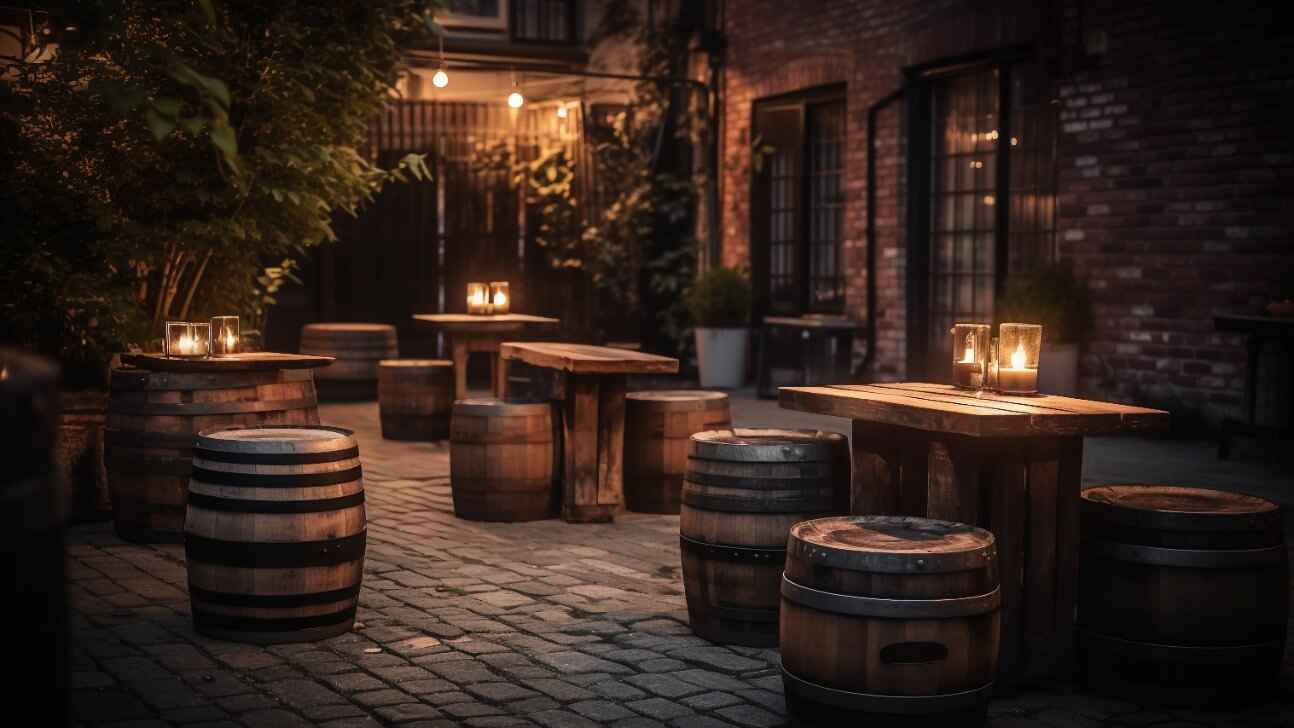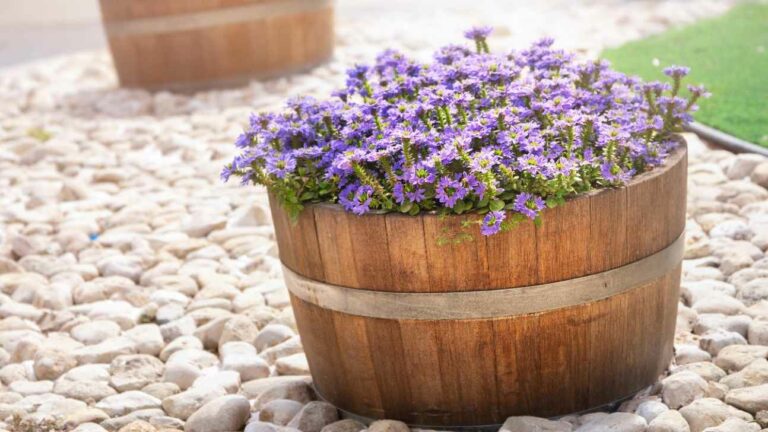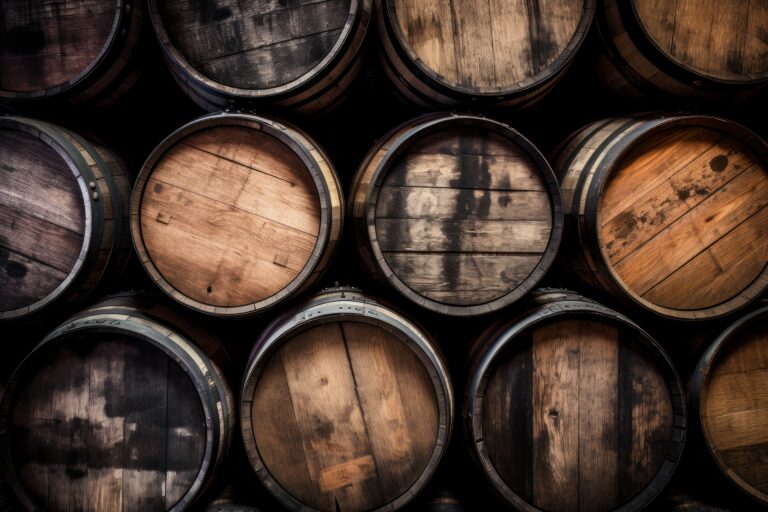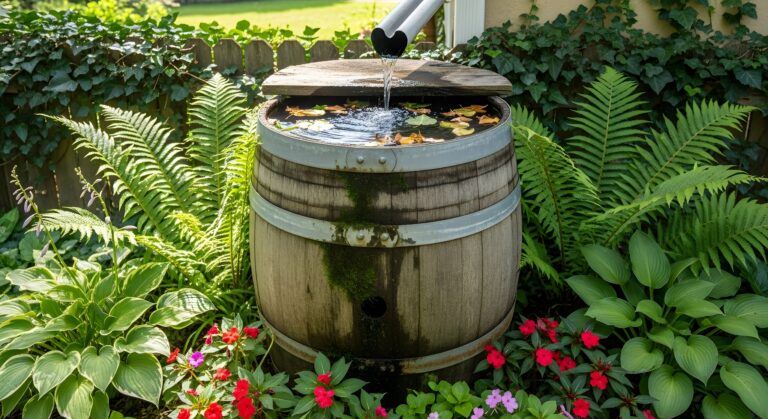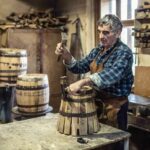So you’ve recently gotten into whiskey and started amassing a collection of fine bottles. Now you’re wondering if you should store those barrels outside. A lot of distilleries age their whiskey in wooden barrels kept in warehouses, so does that mean you need some kind of climate-controlled room for your stash? Not necessarily. As long as you take some basic precautions, storing whiskey barrels outside can actually enhance the aging process. The key is controlling the temperature swings and exposure while still allowing the barrels to experience seasonal changes. If done right, outdoor aging can impart more complex flavors from the wood and speed up the mellowing effects of oxidation. The result is a whiskey with richer, fuller character in less time. So don’t let the lack of a dedicated cellar stop you from starting your own barrel-aged whiskey project. With some tips for best practices, you’ll be raising a glass of your homemade hooch in no time.
Introduction to Whiskey Barrel Storage
When it comes to storing your whiskey barrels, the most important thing is protecting them from temperature extremes. Leaving them outside can expose them to weather that damages the wood and affects the aging process. However, some limited outside storage is okay if you take proper precautions.
If storing outside short-term, choose a spot out of direct sunlight and weather. An open garage, shed, or barn are good options. The ideal temperature range is between 50 to 70°F. Colder or hotter temperatures can cause the wood to shrink or swell, damaging the barrel.
For longer outside storage, you’ll want a more controlled environment. Build a simple shelter with a sloped roof to prevent rain and snow buildup. The structure should be well-ventilated but offer shade and protection from wind. Regularly check that barrels haven’t warped or started leaking.
The key is managing humidity and temperature. Use a hygrometer to monitor humidity, which should stay between 50 to 70 percent. You may need to use a humidifier or dehumidifier at times. For temperature, check daily highs and lows to ensure they stay in an acceptable range. It may help to shade, insulate or heat the area as needed.
With close monitoring and by providing basic protection from the elements, leaving whiskey barrels outside for a limited time should be fine. However, for the best results during long-term aging, an indoor, temperature-controlled environment is ideal. The extra effort will result in a smoother, more complex flavor.
The Effects of Temperature on Whiskey Barrels
The temperature outside has a big impact on aging whiskey in barrels. Colder weather means the whiskey won’t absorb as much flavor from the wood, while warmer weather speeds up the aging process.
Temperature Fluctuations
Changes in temperature cause the wood to expand and contract, allowing the whiskey to penetrate deeper into the wood. This is good for flavor, but temperature fluctuations can also cause evaporation and oxidation, reducing the overall volume of whiskey over time.
Seasonal Changes
As the seasons change, the temperature swings back and forth. This interaction between the whiskey and wood over the course of a year results in a smooth, complex flavor. The summer heat helps the whiskey absorb more wood sugars and tannins, while the winter cold causes the whiskey to draw in wood flavors at a slower rate.
Location Matters
Where the barrels are aged has an impact too. Barrels aged in more temperate climates with smaller temperature variations will age slower than those in areas with more extreme heat and cold. Barrels aged in hotter climates tend to produce whiskies with more robust wood and spice notes at a younger age.
The Sweet Spot
For most distillers, an average annual temperature range of around 55 to 85 degrees Fahrenheit or 15 to 30 degrees Celsius creates the ideal conditions for aging whiskey. Within this temperature range, the whiskey absorbs an optimal amount of flavor from the wood over time. Colder or hotter temperatures can require longer aging to achieve the same results.
In the end, temperature is just one factor that determines how whiskey will taste after years of barrel aging. But by understanding how temperature impacts the aging process, you can better appreciate the care that goes into producing a quality aged spirit.
Protecting Barrels From Moisture Damage
Protecting your whiskey barrels from moisture damage is critical to ensuring their longevity and the quality of your whiskey. Barrels are made of oak, which can warp, crack and rot if exposed to too much moisture for prolonged periods.
Keep Barrels Raised
Barrels should never sit directly on the ground, concrete or any surface that can hold water. Raise them up on wooden pallets, racks or stands so air can circulate underneath. This allows for drainage and prevents water collecting around the bottom of the barrel.
Cover Barrels
Cover your barrels with a waterproof tarp, canvas or barrel cover when not in use. Secure the covering around the bottom edge of the barrel to protect from rain and snow. Be sure to choose a breathable cover that still allows for some air flow. Non-breathable materials can lead to mold and mildew buildup.
Inspect Barrels Regularly
Check on your barrels at least once a month or after major weather events. Look for any signs of water damage like warping, cracking or rotting staves. Also check that hoops and rivets are securely in place. Make any necessary repairs immediately to avoid further damage. It’s a good idea to sand down and re-stain areas that show water damage to protect the wood.
Consider a Shelter
For the best protection, you may want to consider housing your barrels in a shelter. A simple roof on posts will do, as long as the shelter is open on the sides to still allow for plenty of ventilation. The shelter should be large enough to give barrels ample space on all sides. Regular cleaning and maintenance of the shelter area is also important to prevent excess moisture buildup.
Keeping a close eye on your barrels and taking proactive steps to shield them from moisture will help ensure they have a long, productive life. Your diligence will result in better quality whiskey that you can enjoy for years to come. With the proper care and protection, barrels can last for several decades.
Keeping Pests Away From Your Barrels
Keeping pests away from your whiskey barrels is important to prevent damage and contamination. There are a few things you can do to deter common barrel pests.
Secure the Barrel
Make sure the barrel is securely sealed when aging whiskey. Any small opening is an invitation for pests to get inside. Hammer the bung (stopper) firmly into place and check it regularly to ensure it remains tightly sealed.
Store Off the Ground
Do not store barrels directly on the ground. This makes them more accessible to pests like rodents and insects. Keep barrels raised up on a rack, pallet or stand. Storing them off the ground also improves air circulation which is better for aging whiskey.
Use a Pesticide
You can apply an approved pesticide, like diatomaceous earth or boric acid, around the outside of barrels. These natural pesticides dehydrate and kill pests without contaminating the whiskey. Reapply as directed to deter pests long-term. You should avoid spraying pesticides directly on barrels.
Monitor for Damage
Inspect barrels regularly for any signs of damage or pests. Look for small holes, cracks or chew marks where pests may have gained access. Catching damage early means you can repair or replace barrels quickly before pests contaminate the whiskey. It is a good idea to tap barrels to check for fullness and listen for any strange noises inside that could indicate pest activity.
Store in a Sheltered Area
Keep barrels in a sheltered area, like a barn, shed or warehouse. Storing them exposed to the elements can make them more prone to pest and environmental damage. Shelter will also help moderate temperature swings that can negatively impact whiskey aging.
Following these tips will help ensure your whiskey barrels remain pest-free so you can age whiskey to perfection. Staying on top of barrel maintenance and storage is key to crafting a quality product. Keep your barrels happy and the pests will stay away!
Preventing Barrel Leaks and Spills
To prevent leaks or spills from your whiskey barrels, there are a few precautions you should take.
First, make sure the barrels are securely sealed before moving or storing them outside. The bung, or stopper, should be firmly in place in the bunghole. Check that the hoops, or metal bands, are tight and secure around the barrel staves. If the barrel was previously used to age whiskey, rinse it with water to remove any remaining residue before sealing.
Location
Choose a spot that is level and stable. An unleveled barrel can put stress on the joints and seams, causing leaks. A concrete pad, gravel, or packed earth are good options. Avoid areas where water may pool.
Protection
While whiskey barrels are designed to withstand outdoor conditions, some protection from the elements will help prevent damage. Place the barrels under an overhang, awning or lean-to. A tarp, canvas or waterproof cover can also shield barrels from sun and rain. In colder climates, wrap barrels in an insulating blanket.
Drainage
Drill 1-inch holes in the bottom of the barrel to allow water to drain. Place a tray, pan or basin under the barrel to collect any drips. Check regularly and empty as needed. The drainage holes will also allow for airflow, which helps prevent mold or musty smells from developing inside the barrel.
Stability
Secure barrels to prevent tipping or rolling. You can anchor barrels to concrete pads using bolts, or strap multiple barrels together. For single barrels, drive stakes into the ground and attach the barrel using rope, chain or straps.
Routine Checks
Inspect barrels regularly for any signs of leaks or damage. Check that bungs and hoops remain secure. Drainage holes should be clear. Minor leaks can often be repaired using waterproof wood glue and sawdust. For larger issues, it may be best to transfer the contents to another barrel.
Following these tips will help ensure your whiskey barrels stay sealed, stable and protected when stored outside. With the proper care and maintenance, barrels can last for many years. But at the first sign of major damage or leakage, it is best to replace the barrel. Safety first!
Security Concerns With Outdoor Barrel Storage
Leaving your whiskey barrels outside exposes them to elements that could damage them or compromise your whiskey. Security is a major concern, as full barrels can be extremely tempting targets for thieves looking to steal your whiskey—or the actual barrels.
Theft Deterrent
Keeping barrels in an outdoor storage area, shed, or barn may make them an easy target for theft. Full barrels in particular could be stolen and the whiskey sold on the black market. Installing sturdy locks, security cameras, and motion-activated lights can help deter thieves, but there is always some risk of theft if barrels are left outside. For the safest storage, keep barrels in a locked building like a garage or warehouse.
Weathering
Long term outdoor storage exposes barrels to environmental damage from sun, rain, snow and temperature changes. UV radiation from the sun can cause barrels to dry out, warp and crack. Moisture from rain and humidity seeps into the wood, which can mold the inside of barrels or dilute the whiskey. Freezing temperatures cause barrels and whiskey to contract, which leads to leaks when thawed. An unheated shelter, shed or barn provides protection from the elements while still allowing some temperature variations that are important for maturation.
Pests
Rodents like mice or rats may chew through barrels to access the whiskey, contaminating it with feces, urine or parasites. Insects such as beetles or termites can also damage barrels by burrowing into the wood. Storing barrels on concrete slabs and using rodent bait or traps around the storage area helps control pest damage. Regularly inspecting barrels for signs of infestation or damage allows you to take quick action to prevent loss of your whiskey.
Keeping a close eye on your whiskey barrels and taking appropriate security precautions can help ensure your valuable barrels and aging whiskey stay safe when stored outside. However, for the most secure and controlled aging environment, an indoor warehouse or cellar is ideal.
Ideal Storage Locations for Whiskey Barrels
The ideal storage location for whiskey barrels depends on several factors, including temperature, humidity, and security. The most important factor is temperature. Whiskey barrels should be stored in a cool area away from direct heat sources.
Outdoors
Leaving barrels outside in a covered area like a shed, barn or garage can work well if you live in a cooler climate. Look for a spot that maintains temperatures of 55 to 65 F. Direct sunlight should be avoided since it can cause temperature fluctuations that speed up the aging process and evaporation.
Basement
A basement is an excellent choice for barrel storage. Underground cellars tend to stay cooler year-round and the ambient temperature is usually perfect for barrels. Just be sure your basement does not flood or experience drastic temperature or humidity changes which could damage the barrels.
Air Conditioned Area
If you live in a warmer area, an air conditioned space like a spare room, closet or cabinet may be your best option. Look for a spot that can be kept at 55 to 65 F. Use a thermometer to monitor the temperature and make adjustments as needed using a portable air conditioner or cooling unit.
The location should also be secure from rodents or insects to avoid contamination. Keep barrels off the floor using a pallet or rack and cover them when not in use. Check on your barrels regularly to ensure the location is suitable and the barrels remain in good condition.
With the proper temperature, humidity, security, and care, leaving whiskey barrels outside can be perfectly fine and may even enhance the aging process. But keeping a close eye on your barrels and making adjustments as needed is key. The ideal storage spot for your barrels may take some experimenting to determine based on your climate and available options. But with attentive care, your whiskey will be smooth and flavorful.
Tips for Caring for Your Barrels Outside
Caring for whiskey barrels left outside requires a bit of maintenance to keep them looking their best. Here are some tips to help your barrels thrive outdoors:
Choose a sheltered spot
Place your barrels in an area protected from harsh, direct sunlight and heavy rain. A covered porch, under a tree canopy, or on the shady side of a building are all good options. Avoid spots that get intensely hot, as this can cause the wood to crack.
Seal any cracks
Inspect your barrels regularly for any small cracks or holes in the wood. Seal these up with a waterproof wood filler or caulk to prevent moisture from seeping in. Once sealed, you may want to sand down the area and re-stain the barrel for the best appearance.
Stain or seal the barrel
Applying a coat of stain, sealant or wood preservative before placing the barrel outside will help protect the wood from weathering and damage. Reapply as needed, typically every 1-3 years. Look for a product specifically meant for outdoor wood or whiskey barrels.
Keep the bung hole covered
Cover the bung hole (the large opening where whiskey was originally poured) to prevent rain, animals and debris from getting inside. A bung stopper, cork or wooden plug should do the trick. Check it regularly to ensure it’s secure and sealing properly.
Drain and flip
To prevent stagnant water buildup inside, tilt or flip your barrels over to drain any rainwater that may have collected. Do this at least once a month or after heavy storms. Stagnant water promotes mold, mildew and wood rot.
Bring barrels in for winter
For the best longevity, bring your barrels indoors during winter. Freezing temperatures can cause wood staves to crack. Store them in a garage or shed until the weather warms up again in spring.
Following these easy tips will help keep your whiskey barrels looking their finest for years to come. A little preventative care and maintenance goes a long way in extending the life of barrels outdoors.
FAQ: Answering Common Questions on Outdoor Whiskey Barrel Storage
Storing whiskey barrels outside comes with some risks you’ll want to consider. Here are answers to frequently asked questions about keeping barrels outside.
Will the whiskey evaporate or spoil?
Yes, some evaporation is inevitable when barrels are stored outside. This is known as the “angel’s share.” The evaporating liquid creates a concentration effect, intensifying the flavor of the remaining whiskey. As long as the barrel is kept at a stable temperature and sealed properly when not in use, the whiskey should not spoil. It’s best to avoid extreme heat, direct sunlight or variable temperatures which can speed evaporation and oxidation.
Do I need to seal or cover the barrel?
When the barrel is not being filled or emptied, it should be securely sealed to prevent excess evaporation and oxidation. You’ll want an airtight bung or cork to seal the opening. Covering the entire barrel with a tarp, canvas or barrel cover will provide further protection from environmental exposure when sealed. Remove the covering only when accessing the barrel.
Will the wood swell or crack?
Barrel wood can swell, warp or crack when exposed to moisture. Storing barrels on a raised, covered platform with good airflow underneath helps prevent this. It’s best to keep barrels off the bare ground. Routinely check barrels for any swelling, leaks or cracks and repair or replace as needed to maintain integrity.
Do I need to rotate or move the barrel?
For the best results, whiskey barrels should be rotated or moved during storage. Rotating the barrel, known as tumbling, helps provide even exposure to flavoring agents in the wood. If moving barrels into a storage area for aging, rotate them every 3 to 6 months. Even subtle shifts in temperature or humidity within a storage space can impact the whiskey, so rotating helps create uniformity.
Can I store barrels on their side?
Whiskey barrels should be stored upright on their ends, not on their sides. Storing barrels horizontally can cause leaks as the whiskey eats away at the wood. It also exposes more surface area of the whiskey to oxygen, speeding oxidation. For the best quality whiskey, always store barrels in an upright vertical position.
Final Thoughts
So there you have it, the pros and cons of storing your barrels outside. As with many things in life, there’s no simple yes or no answer. If you’ve got the space and the right climate, aging barrels outside can impart some really interesting flavors that are hard to achieve indoors. But you’ve got to be willing to accept the risks that come with it. Weather, temperature swings, and unwanted guests could all cut the aging process short.
At the end of the day, you’ve got to go with what feels right for you and your whiskey. If you’ve got the patience to nurture those barrels for years at a time, and you’re okay with a little unpredictability, leaving them outside might just produce a spirit unlike anything you’ve tasted before. But if consistency and control are more your style, keeping things inside is probably your safest bet. The choice is yours – just don’t forget to raise a glass and enjoy the fruits of your labor either way!
